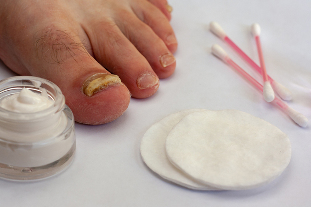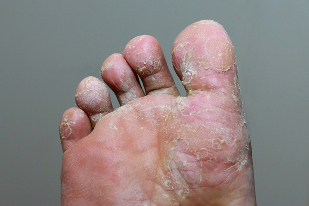The fungus on the toes – the problem, disturbing many. Itching, burning and the unpleasant appearance of the skin and nails is only a small part of it. Disease dangerous complications that cure even more difficult. However, it is possible to tackle the problem, if you take seriously the treatment of fungal infections (mycoses).

Because it occurs the fungus in your feet?
The fungus is one of the types of infectious agents that affect the skin. It is difficult to organized and extremely tenacious microorganisms. Then fungal diseases require a serious and an integrated approach to treatment.
The mushrooms have their favorite places habitats on the skin. First of all, it is the skin of the toes and the nails. The reason for this is clear – the foot usually are the inside of the shoe, the inside of which accumulates a lot of moisture and dirt, but also very hot. Then the fungi present on the plant, a lot of food and a favorable microclimate for reproduction. Some types of complexes of fungi most often affect the skin, and other types of fungi, for example, yeast and shapes, prefer the nail plate. Maybe even simultaneous contamination by several types of fungi.
Promote the development of fungi between the toes:
- reduced local and overall immunity;
- poor hygiene stop;
- uncomfortable and tight shoes;
- it's a change of socks or stockings;
- wear socks or synthetic socks air-tight material;
- new hypothermia or overheating of the feet;
- circulatory disorders in the legs;
- varicose veins;
- chronic diseases of the cardiovascular system, diabetes mellitus;
- along the course of treatment with antibiotics;
- increased sweating of the feet;
- a lack of vitamins and mineral elements;
- mechanical damage of the skin, of the corn, the injury to stop;
- excess weight, excessive physical activity in the foot;
- it is a cutting of hair and nails of the feet.
The most important of these factors – low immunity and poor circulation in the legs. Decreased immunity can occur because of several reasons. Usually it is a serious chronic disease, first of all, infectious. The immunity may decrease due to HIV, taking immunosuppressive drugs, the cancer. Of no less importance and of poor circulation in the toes – due to disease of the blood vessels, the blood, diabetes mellitus, smoking.
Fungal stop can evolve into men and women. Adults appear most often in children.
Some types of fungi is constantly living on the skin and are activated only under adverse circumstances, for example, fungi of the genus Candida. And other types of transmission from person to person. The infection can occur when you visit the gym, the bathroom, the shower, if the man does not enjoy to personal the shoes. Also a substantial risk of contracting exposes people who wear the shoes of someone else, or socks, or give to others to use them. Often the infection occurs when you use the same towels, nail accessories, etc. Factors that increase the likelihood of infection – cuts on the surface of the skin, deformation of the nail plate.
The symptoms of athlete's foot toes
The main symptoms of fungal infection of the feet – itching and burning. There may also be redness of the skin, small blisters, reinforced with flaking and roughness of the skin, bad breath. The first symptoms of the fungal infection of the skin can be mistaken for a simple irritation.
The symptoms of onychomycosis
The fungus can affect not only the skin and nails. This last type of fungal infection is called onychomycosis. The main symptom of onychomycosis – to change the structure and the type of nail, its greater fragility. Nail yellow, on its surface appear grooves and cracks, the nail plate thickens and deforms. If not treated, the nail will gradually become detached from the nail bed and crumble.
As seems to be a fungus on the finger photos
You should not the diagnosis alone, through photos. The diagnosis must be qualified by a dermatologist.
Only he will be able to identify the type of fungus. Because of this, it may be necessary not only for examination outside of the foot, but also laboratory analysis of scrapings of the skin.

However, the presence of signs, even remotely like depicted in the picture – is a cause for concern and to seek medical attention.
The treatment of complex disease and it takes place in the home under the supervision of a doctor.
The fungus on the little finger
The fungus can affect the skin of any finger of the foot. But small fingers on the leg more vulnerable to infections. Little finger into the tight shoes often compressed, because of what on the skin you experience any signs of abrasion, and the circulation of the blood. With the defeat of the nail of your little finger, the disease develops very quickly, more quickly than any other nail. When infected by this finger infection can very quickly touch and the other fingers.
The fungus on the little finger of the foot is treated in the same way, as the fungus in other areas of the skin. During the systemic administration for onychomycosis is the nail of the little finger the most rational solution could be the removal of the nail plate. This operation will not bring large discomfort to the patient, because the nail of the little finger grows quickly. However, until the nail grows again (this can take 3-4 months), it is necessary to use anti-fungal medications to prevent reinfection.
To treat the fungus on your toes?
The treatment of athlete's foot should start at the beginning of the anxiety symptoms. In the first place, it is necessary to consult a dermatologist for the diagnosis. Before starting the therapy, you need to install the fact of the presence of the fungus, and the type of pathogenic microorganisms. With this purpose, the doctor will scraping with the skin or cut a slice of the nail (with the defeat of the nail). Are dealt the analysis of the blood, the blood sugar. Fungal infections of the skin stop, it is necessary to differentiate from:
- other infectious diseases of the skin;
- allergic reactions;
- dermatosis, caused by diabetes, cardiovascular disease, stress and disease.
For the therapy of mycosis of the feet the most often used local means (sprays, ointments, creams). Only in the most severe cases, your doctor may prescribe pills anti-fungal. Often apply tablets fluconazole, itraconazole, terbinafine.
The treatment is based on the use of antimicrobials funds. This type of medication contains substances that kill fungi (fungicidal) or stop their reproduction.
Apply also to local medicines with antibacterial properties, anti-inflammatory and keratolytic properties. Antibacterial are assigned in this case, if there is an infection, that is, to a fungal infection joins bacterial. Anti-inflammatory medications well symptoms the unpleasant – itching and burning. However, they do not prejudge the cause itself of the disease – pathogenic microorganisms. A keratolytic tools include zinc, sulfur and sulfur-salicylic ointment. They accelerate the regeneration of skin tissues, thanks to an acceleration of the exfoliation of the epidermis of the deceased.
For foot therapy, fungal infections apply also to the bathroom with antiseptic properties, means, solutions of potassium permanganate, iodine, salt, sodium bicarbonate, boric acid. The bowl is better to do it before going to sleep for 20 minutes. To prevent contamination by spores develop healthy skin chlorhexidine, iodine, hydrogen peroxide, potassium permanganate. For the therapy of onychomycosis of the nails with antifungal substances. These paints must be applied on the nail plate.
Ointments and creams, it is necessary to apply a pre-washed and clean the skin at the frequency specified in the instructions to the function. The scope of application of the ointment should be a little bit more of the field of apparent defeat. For application on nail plate nail Polish nail you need to steam, jagged edges of his polished nail file, and nail surface degrease with alcohol solution.
In the popular medicine to get rid of fungal infections of the feet are used decoctions of medicinal herbs – chamomile, calendula, sage, st. john's wort, mint, a solution of vinegar, onion and lemon juice.
What to do if the fungus on the finger does not pass?
The treatment of athlete's foot – a long and difficult process. Fungal micro-organisms are very tenacious, and for a couple of days to get rid of them is impossible. Sometimes you will need many months of careful therapy. When this is not possible to stop therapy for a day. Treatment of onychomycosis is not possible to complete until you grow back new, healthy nail plate.

It is important to consider also other factors associated with the development of the disease. The non-respect of the hygiene of the skin, for optimal temperature stop can frustrate all therapeutic efforts. This means that it is necessary to wash the surface of the skin stop, to prevent them from overheating or hypothermia. It is also important to avoid mechanical damages of the skin, excessive load on the foot, cuts and injuries. Excess weight increases the pressure on the foot, and then, if you are suffering for the sake of completeness, it is worth thinking about ways to lose weight.
If the patient is infected by a fungus shoes, here will not help anyone to powerful drugs, because the place of the dead micro-organisms immediately take care of new. Therefore, it is necessary to get rid of all of the factors that contribute to recontamination. You can't walk in the shoes of someone else, socks. The socks must be washed thoroughly, and change regularly. The inner surface of a shoe must be carefully spray the anti-fungal means.
When resistant avium need to analyze the general state of health. Maybe this will help you to identify the causes of disorders, immunity and circulation in the legs. So maybe it is worth to spend a full examination and eliminate the problems with the heart, blood, blood vessels, organs of the endocrine system.
Finally, it is not excluded that the microorganisms developed resistance to the used antimicrobial function. Then you will need to change the medication. Perhaps, it will be necessary, the antimicrobial drugs in the pills. The dosage of the drugs must choose from the specialist dermatologist.
























